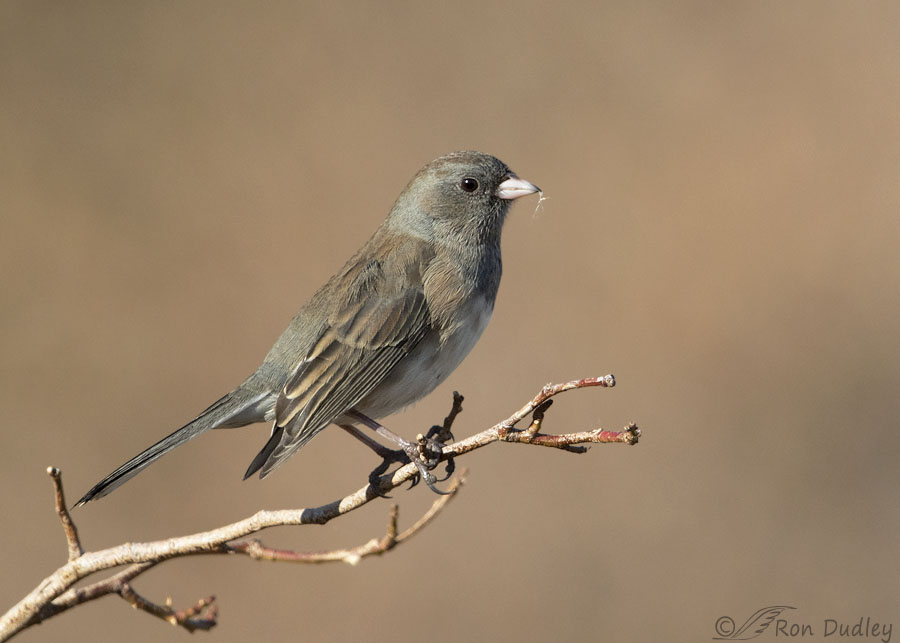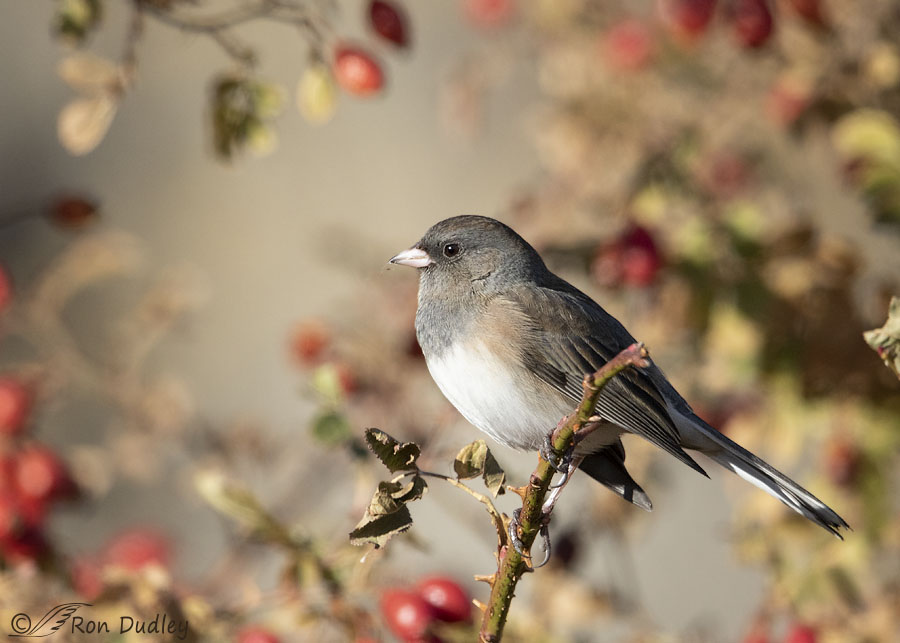Dark-eyed Juncos are a species I rarely feature on Feathered Photography which seems illogical for such an abundant, ubiquitous, conspicuous and often tame bird.
Over the years I’ve posted over 10,000 bird photos to my blog and only four of them have been images of juncos. In winter these “snowbirds” flock to feeders in large numbers where they’re easy to photograph but I don’t photograph birds at feeders and I’ve found them difficult to approach in the wild. But yesterday morning in a remote area of Box Elder County my luck with them changed.

1/3200, f/6.3, ISO 800, Canon 7D Mark II, Canon EF 500mm f/4L IS II USM + EF 1.4 III Extender, not baited, set up or called in
This one posed briefly on several parts of the twig but my favorite shots were taken when it eventually reached one end of it and turned to give me a side view. There’s a fluffy seed in its bill, I have a clean background and there’s nice light on the bird.
This photo style is often referred to as “bird on a stick” but if the BOS style doesn’t appeal to you…

1/3200, f/6.3, ISO 800, Canon 7D Mark II, Canon EF 500mm f/4L IS II USM + EF 1.4 III Extender, not baited, set up or called in
perhaps this shot taken two minutes later in more of the “bird in habitat” (BIH) style will foot the bill. I deliberately cropped a little more loosely on the bird than I usually do to include more of the wild rose hips in the frame. The rose hips are out of focus but I think they add nice color and provide almost a vignette effect around the junco.
The many subspecies (groups) of juncos are a confusing bunch that have confounded taxonomists for generations resulting in a “turbulent” taxonomic history and a “nightmare” for ornithologists. And they confuse the hell out of this bird photographer with only amateur skills at bird ID. My best guess is that the bird in the second photo might be a hatch year Oregon Junco but I’m thoroughly stumped by the first junco above.
A little help from my friends?
Ron


I love the splashes of red in the second photo. I usually see them on the ground but in shadow from the tree above, so it can be difficult to get the lighting correct. Both images feature the bird quite well. I checked Sibley’s and the slate coloured and Oregons meet in the Canadian Rockies, “producing a broad intergrade population.” Perhaps it could be a female Slate-coloured.
Late to the party, Ron, but I love both of them!
Good. Thanks, Diane.
Juncos, every time I think I understand the types I find one I can’t identify!
Exactly.
I like both shots. Pretty bird.
Thank you, Jean.
Huge thanks to you and your knowledgeable (excluding me) commentators.
I really liked both images, but this morning the second has my vote.
Thank you, EC.
I make the top bird a female J.h. cismontanus, aka Cassiar junco.
Martha, Dan Gleason (below) has a similar opinion. Thanks.
When I was first learning birds many years ago, it was easy. There were Oregon Juncos and Gray-headed Juncos in the west (different regions) and Slate-colored Juncos in the east.. But they are all considered the same species now under the name of Dark-eyed Junco. It is indeed very confusing to tell them apart and I must admit that I’ve made little effort to do so. My guess (and it’s just that – a guess) is that this bird may be the sub-species referred to as “Cassiar Junco”. Unfortunately for birders, this is a very complex species with many intermediates to complicate the issue. Juncos are often used as models for studying evolution. For example, a population in southern California that was formerly migratory has become sedentary and s now showing its own unique behavioral and subtle plumage patterns. So, ID of sub-species is a challenge, but I’ve no problem telling you that these are wonderful photos of a fascinating bird.
Dan, I knew that juncos were both complex and confusing but I didn’t know their evolution could be so… volatile. Thanks for weighing in.
I’m no help whatsoever. I can’t even deal with the various sub-species of redtails and I’m literally hopeless with falcons, so what are the chances?
All that said, I used to love it when the snow birds like juncos showed up at my feeders in Dallas and Fort Worth. Here? Not so much. Seems not many folks like to winter here. Even my beloved vultures beat wings for some other where, SIGH!!
Laura, it makes me feel better to know that even you struggle with red-tail variants. Sometimes I can’t even ID a Harlan’s with any confidence.
These got my attention as neither is what I call a Dark-eyed Junco here! The ones we have are more grey with a VERY dark head.. Now I’m going to have to pay more attention to them IF they are still here! I always see them on the ground. Wouldn’t be the first time I’m misidentified something.. Both photos are wonderful……
Both photos are wonderful…… 
Judy, it’s my understanding that all juncos are now classified as Dark-eyed except for the Yellow-eyed Junco which isn’t found in our area. It sounds like the junco you’re seeing might be the Slate-colored which is found in our area year-round.
Think you’re correct. “Invasion” of the Grey-crowned Rosy Finches this morning so Junco’s may be hard to spot…….
Jealous of your finches, Judy…
Slate they are – got the glasses on them – bit of brown in the back but mainly “slate” with darker heads……… Thx!
I think the photograph of the junco with the rose hip background is enchanting! I agree with you all about the vintage look. It reminded me of beautiful screens that ancestors of mine used to paint and display in bedrooms… I’m very fond of juncos. So I’m delighted to see them posted here.
That one’s my favorite of the two also, Alison. I really like the detailed clean look at the bird in the first photo but it just doesn’t have that pizazz…
Your photos manage to reflect the subtle but beautiful variations in coloration of these birds. Juncos are like fingerprints….
The manicotti was delicious. My wife even liked it, a rare victory for my culinary experiments. Thanks for recipe.
“The manicotti was delicious”
I’m absolutely delighted to hear that, Lyle! And to know that you were the cook. A little messy to prepare but very well worth it in my view. You might be interested to know that I gave the grocery manager at Smith’s (Kroger) hell for having stopped carrying tomato puree. He said he’d try to order some again and two days ago it was once again on their shelves. I stocked up…
“Juncos are like fingerprints” – loved that too. So true.
One of the cute little birds I love! Your vignette is lovely…the look of the background is that of an ‘old-fashioned wallpaper’ look. The slight touches of red and green on the twig blend well with everything in the background. No help here with the junco in the first…we tend to mostly get ‘Slate-Colored’ with some ‘Oregons’ and some blends for added interest. They arrived at my feeder a few weeks ago and are increasing in number.
Kathy, you’re absolutely right about the “old wallpaper look”. I hadn’t thought of that. Some old fashioned furniture fabrics look like that too. I actually have a living room chair covered in fabric that looks quite like this background. That chair is dated and ugly as hell but I love it – it’s very comfortable.
Great way to start the morning right after a freak hail storm here. Abundant, ubiquitous, and conspicuous they definitely are. Here in our forests and around our lakes it has been rare for me ever to see them on a branch. 95% of the time when I see them they are foraging on the ground. These are really nice photos. I am certainly not qualified to distinguish, but that second one does appear to be an Oregon Junco. Perhaps some of your more knowledgeable birders will supply the correct identification.
I see them on the ground most often too, Everett. Thankfully these two took a break from foraging down there and went to elevated perches.